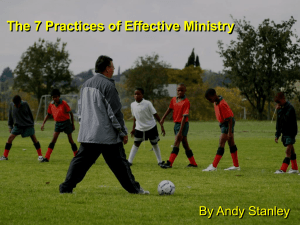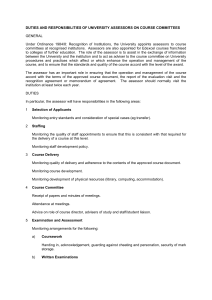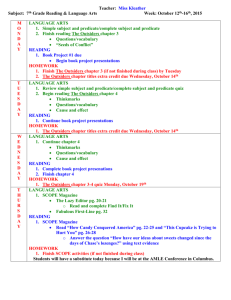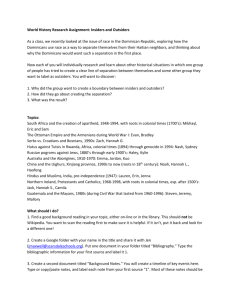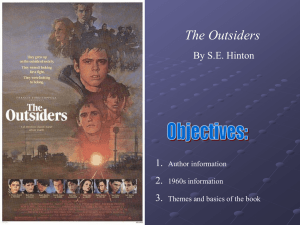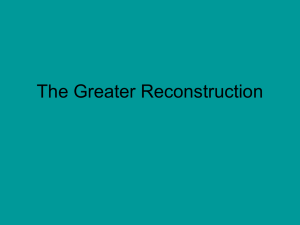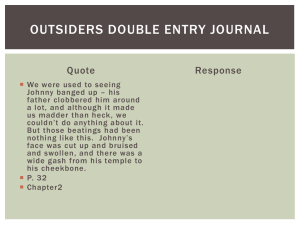Assessing your institution`s culture. - ASGE6130
advertisement
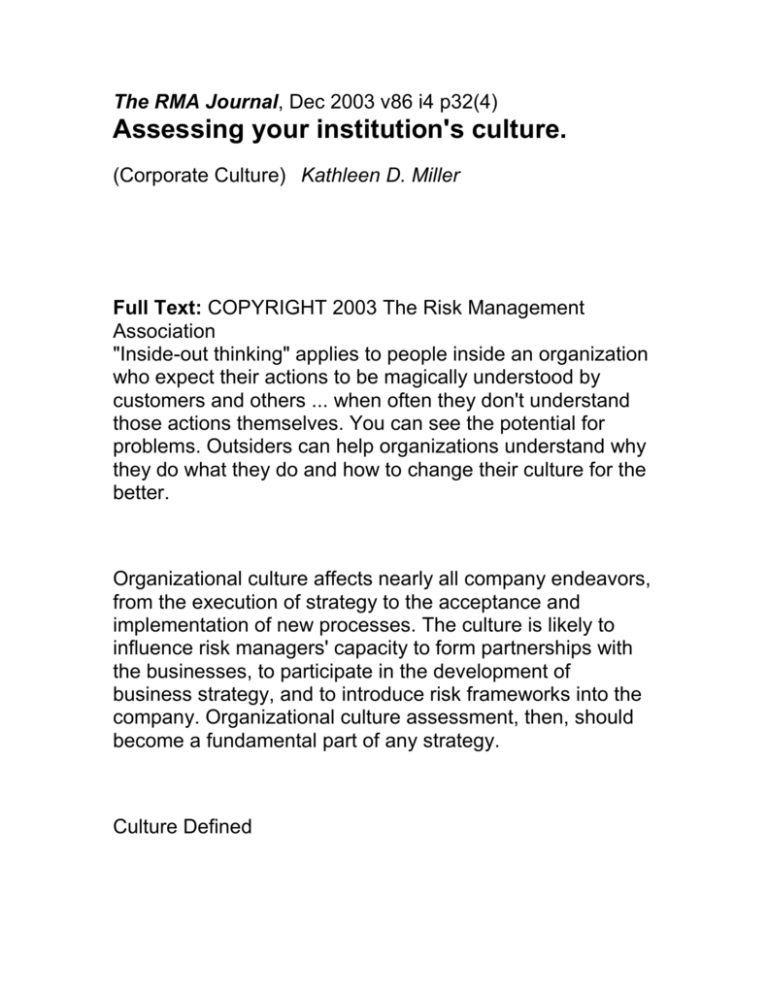
The RMA Journal, Dec 2003 v86 i4 p32(4) Assessing your institution's culture. (Corporate Culture) Kathleen D. Miller Full Text: COPYRIGHT 2003 The Risk Management Association "Inside-out thinking" applies to people inside an organization who expect their actions to be magically understood by customers and others ... when often they don't understand those actions themselves. You can see the potential for problems. Outsiders can help organizations understand why they do what they do and how to change their culture for the better. Organizational culture affects nearly all company endeavors, from the execution of strategy to the acceptance and implementation of new processes. The culture is likely to influence risk managers' capacity to form partnerships with the businesses, to participate in the development of business strategy, and to introduce risk frameworks into the company. Organizational culture assessment, then, should become a fundamental part of any strategy. Culture Defined Practically speaking, organizational culture is "the way we do things here." Culture is composed of the values, basic assumptions and beliefs, and ways of working that members of the organization share. Since these beliefs generally function at an unconscious level, they tend to be taken for granted by organizational insiders. Culture tends to be felt by those within it, yet remains invisible. While it's rather obvious that organizations vary in their look and feel, the nature of these differences often remains elusive and difficult to define. Therefore, assessment of the culture is difficult at best. Nevertheless, even the invisible can be brought to light with the right assessment process. Insider and Outsider Roles in the Assessment Process Thorough and useful assessments of an organization's culture generally require the efforts of those who are inside the culture and live it every day, partnered with the more objective perceptions and observations of someone outside the culture. The outsiders are more likely to observe things that insiders take for granted. They can look for the patterns in behaviors and the surprises or unexpected events. The insiders can attempt to help the outsiders decipher what the events and surprises mean. The primary role of the outsiders is to gather data concerning what goes on in the organization through systematic observations. They collect information through interviews and focus groups, and they review strategic plans, news releases, internal memos, newsletters, and other company documents. In addition, they should attend a few organizational functions, such as meetings and celebrations. In most cases, they should spend some time within the culture, chatting with people informally in the lunchroom, break room, or wherever groups gather. They primarily seek to note surprises--unexpected behaviors or events that provide fertile data for interpreting what makes a culture unique. The primary role of the insiders is to point the outsiders in the right directions for collecting data and to assist with its analysis and interpretation. While the outsiders will notice things that the insiders might take for granted, only those who work within the culture can really clarify or validate the meanings of the events and surprises. Assessment Targets Organizational culture is not a tangible entity. Rather, culture is experienced in a variety of ways. While some of the markers of an organization's culture are quite visible, others are below the surface and somewhat difficult to unearth. Edgar Schein, in his 1992 book Organizational Culture and Leadership, described three levels of cultural markers, as seen in the table at right. A sound assessment process will incorporate all three levels into the data collection plan. While values and assumptions are sometimes difficult to access, one of the most valuable contributions that assessors can make is to bring them to the surface and work with insiders to analyze how they contribute to the cultural picture. For example, risk managers certainly would want to uncover the organization's values and basic assumptions about risk in their culture assessments. Risk managers need to know how risk is defined in the culture, as well as how it is viewed. Since basic assumptions operate like realities, the risk manager in risk-averse cultures has challenges that differ from those who function in cultures that embrace risk as a normal part of business strategy. Assessment Process Steps Step 1--Determine the purpose of the cultural assessment. Exactly why do you want to learn more about the culture? Since the information to be gathered can be quite extensive, target your data collection by focusing on an assessment goal. Have you identified problems that must be addressed? Or do you see new opportunities that you suspect would require a culture change? Are you interested in assessing your current culture's ability to support a new organizational strategy or direction? For example, perhaps you are considering establishing a more robust risk management strategy that would require tighter integration of the processes into the overall structure of the organization. In this case, the culture assessment would be targeted toward all aspects of the culture that could affect your ability to carry out this strategy. Step 2--Identify the types of data that you need to collect. Once you have determined why you are collecting data in the first place, you must outline the types of data that will serve your purposes best. For example, if your purpose is to assess the organization's readiness for a new, more integrated risk assessment strategy, your data collection will be fairly extensive. You might want to study how decisions get made, where the sources of power lie, and how people relate to power relationships. You would want to look at communication flows within the organization and how people relate to cross-functional responsibilities. You may want to assess core values pertaining to risk and how these values influence actions. On the other hand, if you are trying to fix an organizational problem, your data collections will be more focused. You will concentrate on assessing the causes of the problem and how the culture contributes to these causes. Always ask yourself how you will use the data once you collect it. If you can't answer that question, you may be wasting your time in collecting the data in the first place. Step 3--Determine how you will collect the data. Once you have pinpointed the data that you need, you must determine how to collect it. Unfortunately, collecting useful data on a culture isn't always a straightforward process. In most cases, outsiders should be involved in the data collection. An outsider is anyone who is not part of or directly affected by the culture under study. Of course, you will need to work closely with the outsiders to point them in the right direction, assist them in collecting data, and help them interpret the data. In general, an assessor begins by looking at the more visible cultural markers or artifacts. For example, if you are interested in assessing orientation toward power, you may want to look first at the visible signs, such as how offices are positioned. Are the offices separated by level in the hierarchy? Are there differences in the sizes of the offices? How do people at various levels in the hierarchy communicate with each other? The purpose of collecting artifactual data is to get a sense of the look and feel of the culture regarding the target issue. Next, assessors may want to collect data at the second and third, or values and assumptions, levels. A straightforward method for gathering this data is to ask people throughout the organization why they are doing what they are doing. Assessors frequently will ask people to comment on some aspect of the artifacts. For example, if those higher in the hierarchy are located on different floors from those who are lower in the hierarchy and these groups interact only formally, the assessor might ask people throughout the organization why this is the case. As people answer this question, the assessor will continue to probe for the underlying assumptions. Employees might tell the assessor that the company has chosen to organize the offices by level so that the officers of the company can access each other more easily. They may say that the officers frequently need to confer with each other on strategic issues. The assessor might point out that the senior officers are rarely in their offices at the same time, thus making spontaneous conferences unlikely. By drawing attention to this inconsistency, the assessor is likely to get at the underlying reasons for segregation by floor. Perhaps the interviewees then will say that the officers are located on the higher-level floors to protect them from interruptions from their subordinates. They may go so far as to say that they believe all organizations have ways of protecting their senior leaders from those lower in the organizations. At this point, the assessor has gotten to a basic assumption about power in the organization. People within this culture believe that those who are at the top of the hierarchy must be protected from those who are at lower levels. Of course, the assessor could probe further and try to find out why people think that the leaders need to be protected. Remember to probe only for information, values, and assumptions that will shed light on an aspect of the culture that will affect your targeted goal for doing the assessment in the first place. Step 4--Analyze the data. In a cultural assessment, data collections and data analysis are often intertwined rather than sequential. For example, as assessors listen to the stories and legends of the organization, they are continuously looking for patterns and are undoubtedly interpreting what they see and hear. Nevertheless, at the completion of the data-collection process, the insider and outsider assessors should do a systematic and complete analysis of all of the data and the implications for the issues targeted by the assessment process. For example, in the case of the desire to implement a more integrated risk assessment framework into the organization, the assessors will want to analyze the data to determine whether the culture is likely to support or resist this change in direction and strategy. They will look at patterns in the data collected around the targeted dimensions, such as risk values, cross-functional relationships, communication patterns, and decision-making processes. A solid understanding of the culture into which change is to be introduced will provide a sound foundation for planning how to implement the changes. Conclusion Organizational culture is intangible yet powerful. Leaders should never underestimate the power of culture to support or hinder the implementation of strategy. Although cultural assessment is not easy, with the right combination of inside and outside assessors and a clear purpose and method, the process can yield information that will pave the way for the success of any organizational change effort. Assessment: A Two-Way Street Outsiders' Roles Insiders' Roles Systematic observations through: Partnership with outsiders by: Interviews/focus groups Pointing them in the right directions for data collection Company documents them with the relevant Providing documents Company stories, legends, Conveying the organizational and history legends, and history stories, and to: and to: Work with the insiders to the data for outsiders Decipher analyze data Push insiders to examine events the outsiders in testing and behaviors for the underlying hypotheses and uncovering assumptions assumptions that reside within Assist the culture. Levels of Cultural Markers Artifacts the culture; Those things at the surface of anything that one can see, hear, or feel--e.g., physical environment, language, technology, stories, myths, and Artifacts observable rituals and ceremonies. Usually easy to observe but not always easy to interpret. The question that elicits descriptions of artifacts is, "What is going on here?" Espoused Things below the surface, such as strategies, Values goals, preferred solutions, or a Espoused sense of what ought to be versus what Values is. Frequently easy to access in speeches, signs, and interviews. The question that elicits the espoused values is, "Why are you doing what you are doing?" Basic Taken-for-granted beliefs, thoughts, and Assumptions assumptions, usually unconscious and Basic strongly held; treated as realities rather Assumptions than the preferred solution among several alternatives. Very hard to uncover, especially by those within the culture. Kathleen Miller, Ph.D., is president of Miller Consultants and Miller Performance Solutions. Miller Consultants performs culture assessments and offers change strategies, executive coaching, and other training and organizational development systems. Miller Performance Solutions offers change process tool kits, leadership style and skill assessments, and training workshops and seminars. Miller can he reached by e-mail at kathy@millerconsultants.com. Readers are invited to visit www.millerconsultants.com and www.performance-solutions.biz. Article A110961843

